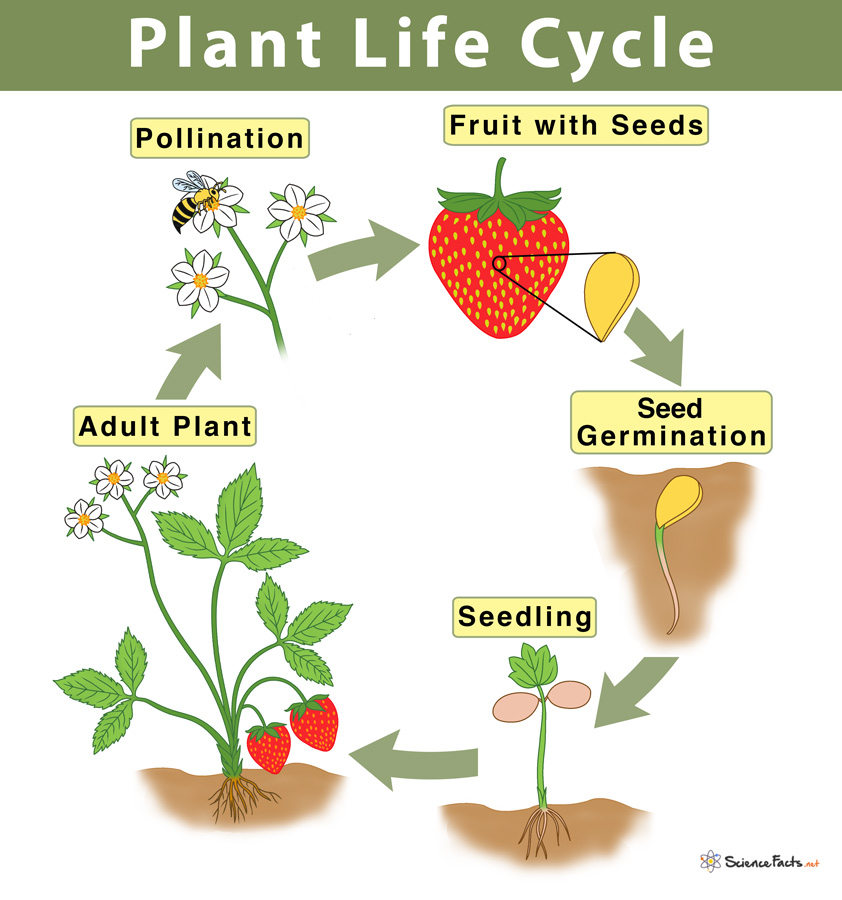Plant Life Cycle Study Guide
Introduction
Like all living things, plants grow, reproduce, and go through a life cycle. The life cycle of a plant explains the many stages of the plant’s existence, beginning with seed and ending with a mature plant. Let’s go through them together below!
The Life Cycle of a Plant
The Plant Cycle can be broadly divided into phases: the haploid phase, the gametophyte phase, and the diploid phase, also known as the sporophyte phase. The alternation of generations refers to how these stages alternate.
Plants, algae, fungus, bryophytes, and pteridophytes exhibit generational alternation. Mitosis and meiosis split both haploid and diploid cells in the life cycle of plants, resulting in haploid and diploid plant bodies.
Four Stages of Plant Life Cycle

Flowering plants are plants that produce flowers. Flowering plants go through several stages: Germination, Pollination, Fertilization, and Dispersal.
Germination
- This is the stage at which the plants begin to sprout from the seed. In this case, the seed’s root develops beneath the earth, while the upper body stem and leaves grow above it.
Pollination
- This occurs when pollen from one bloom is transferred to another flower of the same species by the wind, a butterfly, or an insect. Through this process, the anther of one plant is transferred to the stigma of another plant.
Fertilization
- Fertilization happens when pollens interact with the stigma of other flowers and go to the ovary, where they generate male and female gametes.
Dispersal
- Wind, animals, and water spread or scatter the seeds at this stage. These seeds germinate and grow into a new plant.
Plant Growth
Growth is the most basic feature of all living organisms, and it is a permanent and irreversible metabolic process. Every living species, whether it is plants, animals, birds, or insects, goes through the process of growth-increasing in size. Plants have the remarkable capacity to grow indefinitely during their cycle of life.

Plant growth comprises four phases, each distinguished by unique traits and functions. Plants experience birth, development, reproduction, and death, and how the seeds are spread might alter once it has been duplicated. Here are the four phases of plant development.
1. Seed
The life cycle of a plant starts with its seed. It germinates and thrives if the conditions are favorable. For this reason, each variety of plants will have distinct methods of germinating. The embryo of the plant is contained within these seeds.
2. Germination
The germination phase occurs after the seed is at a location where the requirements for its birth are met. These essential ingredients are light, water, and heat, which vary depending on the plant. A few days after germination, the seed’s first radical will appear, expanding and developing like a common root, and the seed’s outer coat will peel away.
3. Seedling
When the plant begins to grow, it is in a stage known as “seedling”, The cotyledons (primordial leaves) are open, and the plumule develops, allowing the plant’s initial leaves to grow.
4. Increase
The plant life cycle is followed by continuous growth of the plant. The plant produces food to continue growing through a process is known as photosynthesis, and the capacity to do so is gained as the first leaves appear.
✅ Conclusion
-
Plants are considered living entities, and they reproduce and grow to survive.
-
They go through a life cycle that starts with the germination of a seed and moves to the seedling phase and finally the growth phase.
-
Unlike animals, plants have the capacity to grow indefinitely.
FAQs
1. What are the 5 stages of the plant life cycle?
Plantlife cycles consist of five stages: seed, seed germination, seedling, adult plant, and pollination and fertilization.
2. What is the life cycle of a plant?
The life cycle of a plant outlines the several phases of the plant’s existence, beginning with seed, germination, seedling and ending with the mature plant.
3. What are the 3 life cycles of a plant?
The 3 life cycles of a plant are Haplontic, Diplontic and Haplodiplontic.
We hope you enjoyed studying this lesson and learned something cool about the Plant Life Cycle! Join our Discord community to get any questions you may have answered and to engage with other students just like you! Don’t forget to download our App to experience our fun, VR classrooms – we promise, it makes studying much more fun! 😎
]]>